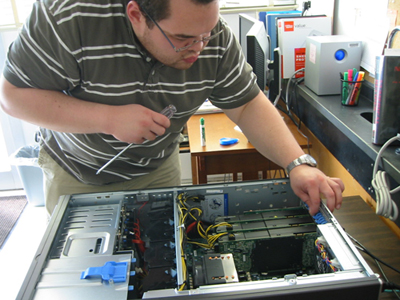Chris Mauzey
Chris now works as a computer scientist at Lawrence Livermore National Labs.
While in Chico, Chris worked on ways to accelerate the execution of programs used to process the REAL data. Sometimes it's as simple as refactoring inefficient code. But, the largest and most exciting gains result from the deliberate use of vector processing capabilities of CPUs and massively parallel processing capabilities of graphical processing units (GPUs).
For example, by using the branchless vectorized median (BVM) filter algorithm, he was able to make our high-pass median filter ~70x faster than the IDL implementation. It was programmed in C and used Streaming SIMD Extensions and OpenMP; it ran on a 6-core 3.33GHz Xeon 5680. Further acceleration was gained when using the BVM algorithm implemented in CUDA C, which was almost twice as fast as the previous example when running on an nVidia Tesla C2070. He also used the library GPULib from Tech-X Corp, which helps in refactoring IDL code to run on CUDA-enabled GPUs.
Chris coauthored 4 peer-reviewed journal articles and 13 conference presentations including the three below.References
Mauzey, C. F., P. Dérian, and S. D. Mayor, 2014: Wavelet-based optical flow for real-time wind estimation using CUDA, Poster presentation 4253 in CV09. GPU Technology Conference (GTC), 24-27 March, San Jose, CA. Poster
Mauzey, C. F., J. P. Lowe, and S. D. Mayor, 2012: Real-time wind velocity estimation from aerosol lidar data using graphics hardware. Poster presentation AV10 at the GPU Technology Conference (GTC), 14-17 May 2012, San Jose, CA. Poster
Mauzey, C. F., J. P. Lowe, S. D. Mayor, 2011: The Use of Graphics Hardware in Computing Wind Velocity from Aerosol Data. College of Natural Sciences Poster Session. Poster
